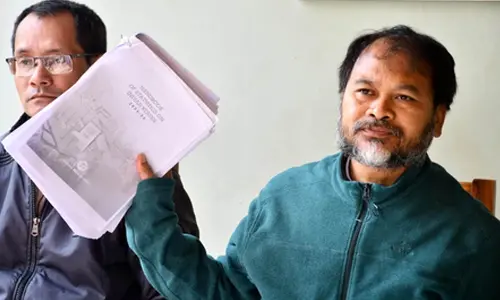India should be aggressive to achieve zero food poverty among children

UNICEF defines child food poverty as children’s inability to access and consume a nutritious and diverse diet
For multiple reasons, our fight as a nation against poverty in general and zero food poverty among children has been sluggish from very inception. The most prominent among all the reasons is the lack of an inclusive set of socio-economic and educational policies aimed at checking growing population, exploitation of weaker sections of society on the basis of their social identities, rampant inequalities and social brutalities arising out of monstrous income disparities and multifaceted deprivations. As a result, the deprived among us continue to struggle a lot to lead a decent life, though our Constitution empowers every citizen with the right to lead his life with dignity. Needless to say, the trauma of starvation is a ruthless attack on one’s dignity and its repercussions have a crippling effect on the victims of food deficiencies.
A study that used data from the Union Health Ministry’s National Family Health Survey (NFHS) for 2019-2021 has estimated the prevalence of zero-food children in India at 19.3 per cent, the third highest after Guinea’s 21.8 per cent and Mali’s 20.5 per cent. The figures are much lower in Bangladesh (5.6 per cent), Pakistan (9.2 per cent), DR Congo (7.4 per cent), Nigeria (8.8 per cent) and Ethiopia (14.8 per cent). The United Nations International Children’s Emergency Fund (UNICEF) report titled ‘Child Food Poverty: Nutrition Deprivation in Early Childhood’ also showed that India is among 20 countries that account for 65 per cent of the total children, who lived in severe child food poverty between 2018 and 2022.
The other countries with severe food poverty among children include Afghanistan (49 per cent), Bangladesh (20 per cent), China (10 per cent), and Pakistan (38 per cent). Globally, about 181 million children -- or 1 in 4 - under five years of age are experiencing severe child food poverty, according to the report based on data from nearly 100 countries. Of these, around 64 million affected children are in South Asia, and 59 million are in Sub-Saharan Africa. However, the report also showed that India is among 11 countries to make progress. Besides India, Armenia made progress in Asia. The other nine countries include Burkina Faso, Cote d’Ivoire, the Democratic Republic of the Congo, the Dominican Republic, Guinea, Lesotho, Liberia, Senegal, and Sierra Leone -- in Africa.
UNICEF defines child food poverty as children’s inability to access and consume a nutritious and diverse diet in early childhood. It recommends eating five of eight main food groups daily – breast milk; dairy products; eggs; meat, poultry, and fish; pulses nuts, and seeds; Vitamin A-rich fruits and vegetables; grains, roots, tubers, and plantains; and other fruits and vegetables. Lack of a nutritious and diverse diet is restricting children’s optimal growth and development in early childhood and beyond. According to the report, extreme food poverty is making children 50 per cent more likely to experience wasting -- a life-threatening form of malnutrition.
In December 2023, 36 per cent of the 89.1 million children less than six years in our country were found to be stunted; 17 per cent were underweight and six per cent children under five years were wasted, according to data by the Poshan Tracker for the month. The levels of underweight and wasting obtained from the Poshan Tracker are much less than that projected by the National Family Health Survey-5 (NFHS-5), Smriti Zubin Irani, the then Union Minister for Women and Child Development, told the Rajya Sabha on February 7, 2024. No doubt, some critical efforts are being made to address the serious health problems of children, arising out of growing inequities, families’ inability to afford nutritious foods, and adopt and sustain positive child-feeding practices, and so on.
If we set aside our personal biases and prejudices, we will agree that child care has never been a serious business for us as a nation. A large number of children from poor families are deprived of nutritious food, personal and social hygiene. They are subjected to multiple forms of exploitation. A good number of them also get enrolled for school education but majority of them either drop out or fail to enter the holy precincts of higher education institutions (HEIs). Such data are in the public domain. Critical stakeholders including those who are a part of the system, those who represent them politically and those who search and research on their plight academically – they all are well aware of the problem but they don’t act with tenacity. They don’t debate why children of weaker sections of society are not getting even adequate food and quality primary education. We need to be alive to the fact that severe starvation among children has profound multidimensional repercussions. It directly impacts their physical health, leading to malnutrition, stunted growth, and increased vulnerability to diseases. They often face social and emotional challenges. Even the economic consequences of child starvation are substantial. When children do not receive adequate nutrition, their future earning capacity is significantly reduced, impacting the national economy. Starvation among children also has intergenerational consequences, as malnourished mothers are more likely to give birth to underweight and malnourished infants. This perpetuates a cycle of poverty and poor health.
Last but not the least, in a country like India, where income and wealth disparities are so pronounced, the effects of starvation are exacerbated among the poorest segments of society. Children from marginalized communities are disproportionately affected. Let us not wait but accelerate the pace of implementing comprehensive policy interventions at every possible level. From strengthening public health infrastructure to improving access to nutritious food through programs like the Public Distribution System, there is a need for massive education and awareness campaigns about nutrition and health. Social safety nets such as conditional cash transfers and employment guarantee schemes will play an important role in alleviating poverty and ensuring food security, leading to a more equitable and prosperous society. The million-dollar question is: Are we really keen to eliminate starvation from our country holistically? Perhaps, not!














